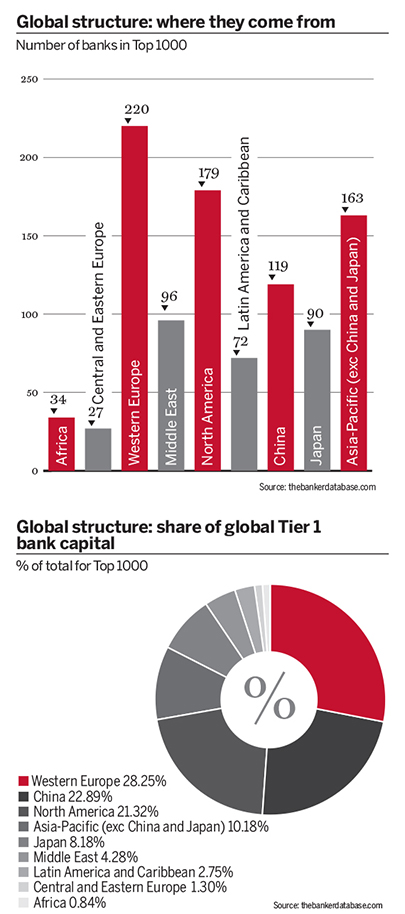Global banking is a very unequal business. The lion’s share of Tier 1 capital is dominated by the three pillars of Asia-Pacific, western Europe and North America, leaving the emerging markets of central and eastern Europe, the Middle East, Africa and Latin America and the Caribbean on the sidelines with a combined share of less than 10%.
While for several years emerging market economies were growing at rates that would have seen them catching up with the big powerhouses, this trend has stagnated or gone into reverse as commodity price have fallen and other woes have led to slowdown and recession. As the Top 1000 is compiled in US dollars, sharp falls in many emerging market currencies such as the Brazilian real and the Russian rouble have accentuated this effect in the rankings.
In percentage of Tier 1 capital terms, the Asia-Pacific region (including China and Japan) accounts for 41.25%, an increase of 2.6 percentage points on the 2015 ranking figure of 38.65%. China accounts for 22.89% alone – in other words, more than half of the Asian continental share. While the renminbi has weakened against the dollar, changes have not been as dramatic as in other markets, allowing China to hold its own in share of bank capital. Japan has increased its share slightly from 7.45% in 2015’s rankings to 8.18%, while the rest of Asia-Pacific has dropped from 10.25% to 10.18%.
North America remains flat at 21.32% compared with 21.03% in 2015’s rankings, while western Europe has fallen from 30.60% to 28.25%.
These trends are reflected more or less in the number of banks in the Top 1000 table, with China adding two banks to go from 117 to 119, Japan adding one to reach 90 and the rest of Asia-Pacific gaining six banks to go from 157 to 163.
North America added seven banks to reach 179, while western Europe lost two banks to score 220.
But it is in the other emerging markets where the big changes have been felt. Central and eastern Europe lost 19 banks, about two-fifths of the 46 in 2015’s rankings, leaving the region with only 27 banks in the Top 1000. This is a dramatic outcome for a region that is underbanked and needs finance to power its economy forward. In percentage of Tier 1 capital terms the region fell from a tiny 1.67% to an even more meagre 1.3%.
The Middle East bucked this trend by increasing its share to 4.28% from 3.88% in 2015’s rankings, and its number of banks by eight to 96. But for Latin America and the Caribbean and Africa the news was dismal, with Africa seeing its share of global bank capital fall even further to 0.84% and losing three banks to field only 34. Latin America and the Caribbean saw its capital share fall from 3.2% to 2.75%, while its number of banks held steady at 72. On current evidence, emerging markets are going the wrong way on the banking front.





